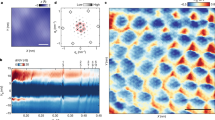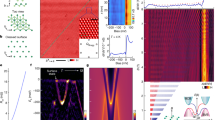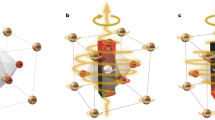Abstract
replying to J. Luo et al. Nature 501, 10.1038/nature12589 (2013).
We agree with Luo et al.1 that the magnetoresistance effects that we reported2 were dependent on the method used to measure them. The reason that there is a difference in the results depending on whether method 1 or method 2 is used (adopting the measurement notation of ref. 1) is that there are two voltage-stabilizing diodes in the Keithley 2400 instrument we used. We were unaware that when this instrument was used both as current source and voltmeter, one diode connected the input port of the current source to the input port of the voltmeter, whereas the other diode connected the output port of the current source to the output port of the voltmeter. The diodes caused a crossover of the Hall coefficient from negative to positive when the instrument was used to conduct a Hall measurement in this configuration, leading us to propose an invalid mechanism for the abnormal magnetoresistance. Therefore the mechanism we proposed2—minority injection and an induced p-n boundary—does not provide a correct explanation for the observed geometry-enhanced magnetoresistance. Although such a mechanism does not operate in our samples, we note that a p–n boundary could still enhance magnetoresistance in certain circumstances according to our and others’ theoretical calculations and experiments2,3,4.
This is a preview of subscription content, access via your institution
Access options
Subscribe to this journal
Receive 51 print issues and online access
$199.00 per year
only $3.90 per issue
Buy this article
- Purchase on Springer Link
- Instant access to full article PDF
Prices may be subject to local taxes which are calculated during checkout
Similar content being viewed by others
References
Luo, J. et al. Low-voltage magnetoresistance in silicon. Nature 501, http://dx.doi.org/10.1038/nature12589 (2013)
Wan, C. H., Zhang, X. Z., Gao, X. L., Wang, J. M. & Tan, X. Y. Geometrical enhancement of low-field magnetoresistance in silicon. Nature 477, 304–307 (2011)
Hu, J. S. & Rosenbaum, T. F. Classical and quantum routes to linear magnetoresistance. Nature Mater. 7, 697–700 (2008)
Parish, M. M. & Littlewood, P. B. Non-saturating magnetoresistance in heavily disordered semiconductors. Nature 426, 162–165 (2003)
Baker, D. R. & Heremans, J. P. Linear geometrical magnetoresistance effect: Influence of geometry and material composition. Phys. Rev. B 59, 13927–13942 (1999)
Author information
Authors and Affiliations
Corresponding author
Rights and permissions
About this article
Cite this article
Zhang, X., Wan, C., Gao, X. et al. Zhang et al. reply. Nature 501, E1–E2 (2013). https://doi.org/10.1038/nature12590
Published:
Issue Date:
DOI: https://doi.org/10.1038/nature12590
This article is cited by
-
Mechanism of capacity fading caused by Mn (II) deposition on anodes for spinel lithium manganese oxide cell
Journal of Wuhan University of Technology-Mater. Sci. Ed. (2017)
-
Effects of neutrophils peptide-1 transgenic Chlorella ellipsoidea on the gut microbiota of male Sprague–Dawley rats, as revealed by high-throughput 16S rRNA sequencing
World Journal of Microbiology and Biotechnology (2016)
-
Protective PVDF-HFP-based membranes for air de-hydration at the cathode of the rechargeable Li–air cell
Journal of Applied Electrochemistry (2016)
-
Adiabatic far-field sub-diffraction imaging
Nature Communications (2015)
-
Review: effect of bimetal interface structure on the mechanical behavior of Cu–Nb fcc–bcc nanolayered composites
Journal of Materials Science (2014)
Comments
By submitting a comment you agree to abide by our Terms and Community Guidelines. If you find something abusive or that does not comply with our terms or guidelines please flag it as inappropriate.



